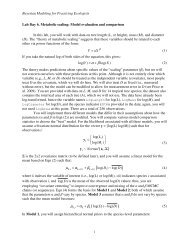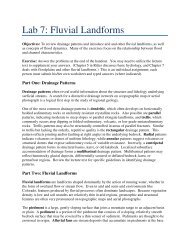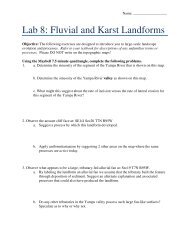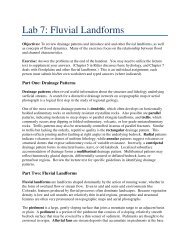1 Study guide for GEOL 454 Final Exam KARST ... - Classes
1 Study guide for GEOL 454 Final Exam KARST ... - Classes
1 Study guide for GEOL 454 Final Exam KARST ... - Classes
Create successful ePaper yourself
Turn your PDF publications into a flip-book with our unique Google optimized e-Paper software.
<strong>Study</strong> <strong>guide</strong> <strong>for</strong> <strong>GEOL</strong> <strong>454</strong> <strong>Final</strong> <strong>Exam</strong><strong>KARST</strong>Requirements <strong>for</strong> karst topography:Carbonates (limestone, dolomite)GroundwaterGroundwater terms you should understandzone of aeration (vadose zone)capillary fringewater tablephreatic zonecone of depressionaquifer (confined and unconfined)/aquitardartesian flowDissolution controlsPermeabilityPorosityBeddingJointsReliefClimate (increased availability of water promotes karstification)VegetationKarst featuresSprings (exsurgent vs resurgent)TravertineDolines (sinks, sinkholes)Uvalas (coalesced dolines)Polje (even bigger than uvala)Valleys (blind, pocket, and dry)Allogenic valleyCockpit/tower topography (tropical karst)CavesControls on cave growth, i.e., flow rate, etcSample question: Typically, runoff in an individual portion of a karst terrain isaccomplished through a relatively large passage, as opposed to many small pathways.Explain the process by which a single passage is <strong>for</strong>med and give an example wheremultiple passages (i.e., mazes) might be favored.1
EOLIANConditions that promote relative effectiveness of eolian processesSparse vegetation; unconsolidated sediment; windResistance (vegetation, clast size, cement)vs Energy (wind direction, velocity, turbulence)Desert pavementwinnowingEntrainment threshold (function of wind velocity, grain size, roughness, packing,moisture/cohesion)Suspension vs saltation vs surface creepAbrasioncontrolled by wind velocity and particle abundance in air columnland<strong>for</strong>msErosionalabrasional: ventifacts, yardangdeflational: deflation hollows, blowouts, pansDepositionalripples, dunes, draa, loessDune typestransverse, parabolic, barchan, longitudinal, star, coppiceSample question: What climatic/physical conditions are necessary to make wind aneffective agent of erosion (e.g., climate, sediment characteristics, etc)?GLACIALGlaciologySnow to ice metamorphosisFirn, firn lineGlacial mechanicsSliding/creepFlowSurging glaciersRegelation (pressure at upstream side of obstruction melts ice, re-freezeson downstream side where pressure is reduced)Stratification of ice; foliationCrevasses (e.g., at localized acceleration, base topography variation)Zone of accumulation vs zone of ablationmain processes in each zonebalance controls advance or recession rate2
Types of glaciersCirque glaciers, valley glaciers, piedmont glaciers, ice caps, ice sheetsActive vs passive glaciersTemperate glaciers vs cold or polar glaciersGlacial geomorphologyErosionAbrasionstriations, grooves, crescentic marksPlucking/quarryingroche moutoneeCirques<strong>for</strong>mation process, beginning with nivationTarns, paternoster lakesTroughs, fjordsCols, arêtes, hornsNunataksDepositional (drift)Non-stratified drifttill (basal, lodgement, ablation, moraine)Morainesend, terminal, recessional, lateral, medial, groundDrumlinsStratified drift (fluvio-glacial, or marine/lacustrine influence)proglacial outwash plain, valley train, sandurkame and kame terraceeskerkettle hole lakeJokulhlaups (glacial outburst flood)as opposed to a moraine dam failure floodGreat Ocean Conveyor Belt(inter-relation of global climate/circulation patterns and glaciation)possible explanation of Younger Dryas periodSample question: What is meant by temperate (warm-based) and polar (cold-base)glaciers? Under what conditions would you be likely to find each? What differenceswould you expect in the nature of erosion, transport, and deposition done by each type ofglacier?3
PERIGLACIALPermafrostActive layer; permafrost table; level of zero annual amplitudeTalikMean annual surface temperature and geothermal heat control depth of permafrostSurface water inhibits permafrost growthContinuous vs discontinuous vs sporadic permafrostDifficulty of construction in permafrost regionsFrost action (freeze/thaw)Frost wedgingFrost heavingCreepFrost push and frost pull (sorting by size)Needle ice (piprake)Frost crackingMass movement: soliflucation and frost creepSolifluction lobesRock glaciers (ice cored vs ice cemented)steep face; flow lobesIce wedges/ice wedge polygonsPingos (open- and closed-system)Patterned groundsorted by grain size (usually fine in middle, coarse at edges)polygons, circles, stripespoorly understood; may be caused by convection of less dense deep material, withdensity differences caused by freeze-thaw processesSample question: How could you recognize periglacial areas on a map or air photo?4
COASTALWavesOrbital motionWave refractionShoalingSurf zone (where waves break)Waves of translationTsunamisStorm surgeTidesspring and neaptidal boresRip currentsLongshore currentsBeach (littoral zone)beach profilebermbeach facelongshore bars and troughsBeach cusps, rhythmic topography, and capesLand<strong>for</strong>msErosionalwavecut plat<strong>for</strong>mmarine terrace (abandoned wavecut plat<strong>for</strong>m)stacks, arches, cavesDepositionalspits and baymouth barstombolobarrier islandstidal inlets, lagoonsEngineering featuresSeawall; breakwater; groin; jettyReefsClimatic indicatorsFringing; barrier; atollKey/caySample question: How are marine terraces <strong>for</strong>med? What mechanisms affect theirelevation with respect to sea level?5
VOLCANICBasalt plateauscolumnar jointingVolcanic neckTephra depositstephrachronologyLahar: volcanic debris flow containing pyroclastic material and water (often from meltingglaciers on the volcano)Nuee ardente: rapid, turbulent cloud of gas and ash; sometimes burningJokulhlaup: glacial outburst flood; can be caused by volcanic heating of glacierSample question: What is tephrachronology? Describe a possible application of it.TECTONICFault scarptriangular facets; sag pondsMonoclinal scarpLineamentShutter ridgesFault block mountainRift valleyHorst/grabenSample question: What climatic conditions favor the preservation of tectonic geomorphicfeatures?6
ARID, SEMIARID & SAVANNA REGIONSCauses of ariditysubtropical anticyclonic beltsmiddle latitudes – distance from ocean, rain shadow, western side of continentsSavannaSemiaridArid land<strong>for</strong>msplayareg/desert pavementdunesinternal drainagepiedmont, alluvial fans and bajadas, pedimentSemiardi land<strong>for</strong>mssteppes/prairies/pampas/veld – grass coverrivers graded externallyplains or low, dissected plateauspediments/alluvial fansSavanna land<strong>for</strong>msinselbergs – double surface of levelingSample question: Explain the processes operating in the two surfaces of the doublesurface of leveling, and how these influence the height to which inselbergs protrudeabove the surrounding plain.7










